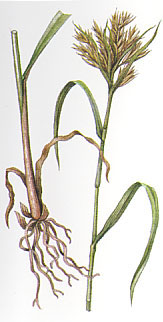
|
|
| Cymbopogon densiflorus - Lemongrass - Gramineae - Warm zones of Africa and Asia |
|
FAMILY: Gramineae (Grass Family) This perennial grass can grow up to 12 inches (30cm) tall, and 1 inch (2.5 cm) wide. The grass blades are rounded at their base, they evenly taper to a fine point and emanate from a strong central stalk. The grass blades range in color from forest green to olive green, the flowers are slender and range in color from olive green to brownish green.They like warm climates and thrive in subtropical and temperate climates, especially in Africa and southern Asia. This tropical grass originated in central and western Africa, specifically in Malawi, the Congo and Gabon; however since the 18th century it has been successfully transplanted throughout South America, Central America and in other tropical climates around the world. Because of this grass's hardy nature and robust growth, it can currently be found growing on almost every continent. Very little research has been conducted on this hallucinogenic plant, what little has been documented has originated form ethnographic studies conducted on the aboriginal tibes of Central Africa. Studies conducted in the early and mid 1970ís by Da Cunha and Koketsu, confirmed suspicions that this species of lemongrass produces psychoactive alkaloids that have been known by aboriginal peoples for centuries. However, modern science has yet to fully investigate this plant and its hallucinogenic compounds. TRADITIONAL USE: Entheogenic and ethnographic research conducted in 1918 by Newbould found that the Tanganyika tribe shaman and witch doctors used this plant to induce vivid dreams and foretell the future. The medicine men in the tribe are known to use this grass to produce elevated states of intoxication, in which they were able to visualize their patientsí ailments and then prescribe an appropriate remedy. TRADITIONAL PREPARATION: Traditionally the Tanganyika medicine man dried the grass blades and flowers and smoked them, sometimes mixing the dried herb with other magical healing plants like Tobacco and Kanna (Sceletium Tortuosum). There are several historical blends that the Tanganyika used to induce vivid hallucinations and to predict the future. The medicine men make a smoking blend using 1 part dried lemongrass and 1 part dried tobacco leaf; a similar recipe that was used by the Tanganyika witch doctors adds 2 parts Kanna to the previous mixture to help them divine the future. MEDICINAL USES: Narrative interviews with the witch doctors and medicine men documented many different medicinal uses for Lemongrass; they used it to relax patients with nervous anxiety, as a diuretic to expel evil spirits; they made a tea that they used nasally to clear the sinuses, and a balm to ease arthritis pains. It is currently believed by herbalists and natural products advocates that there may be high concentrations of antioxidants present in the flowers, and that they may also possess anti-bacterial properties. TRADITIONAL EFFECTS: The few reports that have surfaced about this plantís magical powers mention euphoria, states of deep relaxation, vivid dreams, lucid dreams, and bouts of sleep walking; at higher doses or regular habitual use there are reports of delirium, nightmares, and more prolonged sleep and extended lethargy. |
|
| Related
Articles : |
|
| Email
This Article To A Friend - Print
This Article Articles can be E-mailed to a friend and you can get a printable version of the article IMPORTANT: We provide all information for educational purposes only, and endorse or recommend nothing here. A special thanks to Keith for all his support and insight. |
|
